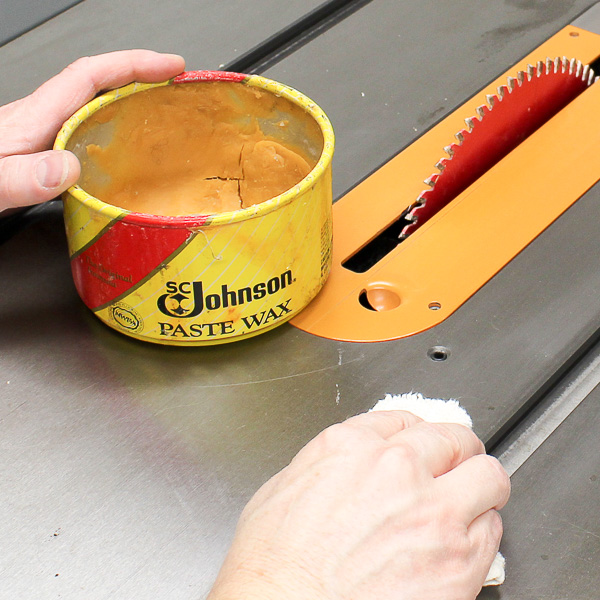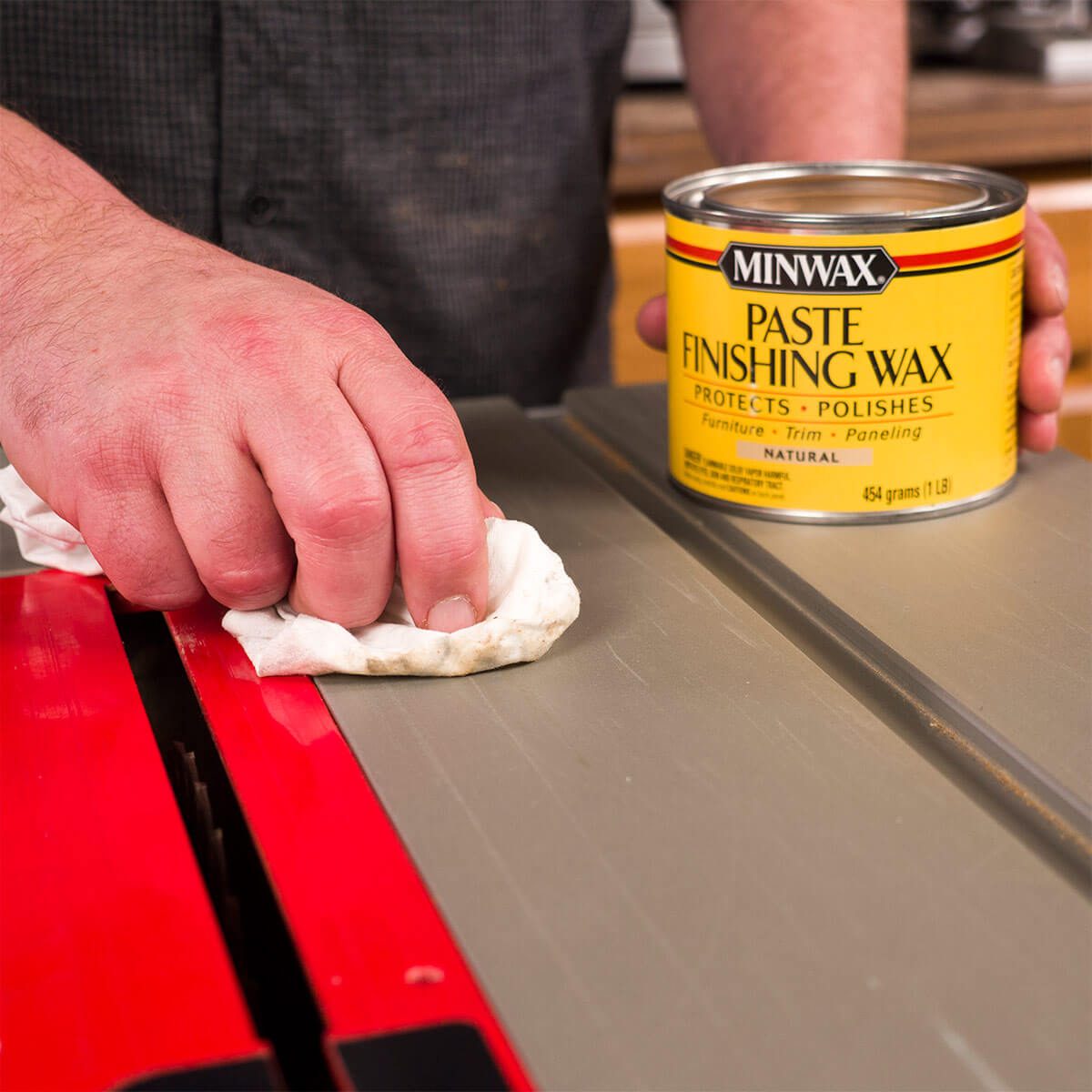If you’re wondering, “What wax should I use for my table saw?” you’ve come to the right place! Table saws are valuable tools that require regular maintenance to keep them running smoothly. One essential aspect of this maintenance is applying the right wax. But with so many options available, it can be overwhelming to know which wax is best.
But don’t worry, we’ve got you covered! In this article, we’ll explore different types of waxes suitable for table saws. We’ll explain why waxing is important and provide guidance on selecting the right wax for your specific needs. So let’s dive in and find out how to keep your table saw running like a champ!

The Best Wax for Table Saws: A Guide to Keeping Your Saw in Top Shape
Table saws are essential tools for woodworkers, but they require regular maintenance to keep them in optimal condition. One crucial aspect of table saw maintenance is applying the right wax. In this article, we will explore the different types of wax suitable for table saws, their benefits, and how to select the best one for your needs.
Why Does My Table Saw Need Wax?
Your table saw’s tabletop is exposed to friction and moisture every time you use it. Over time, this can lead to rust, corrosion, and difficulties in sliding materials across the surface. Applying wax to your table saw helps reduce friction, prevent rust, and maintain a smooth working surface. Additionally, waxing your table saw can make cleanup easier by minimizing the accumulation of dust and debris.
1. Carnauba Wax: The Natural Choice
Carnauba wax is a popular option for table saws due to its natural origin and excellent protective properties. Derived from the leaves of the Brazilian palm tree, carnauba wax forms a durable and hard protective layer on the table saw’s surface. It provides a high-gloss finish, ensuring smooth material slides while offering excellent resistance against water and mild chemicals.
When applying carnauba wax to your table saw, melt a small amount and spread it evenly over the surface using a clean cloth. Allow the wax to dry, and then buff it with a soft cloth for a brilliant shine. Regular maintenance with carnauba wax will enhance your table saw’s longevity and functionality.
Pros of Carnauba Wax:
- Excellent protection against rust and corrosion
- Easy to apply and buff
- Provides a high-gloss finish
- Long-lasting
2. Synthetic Wax: A Modern Alternative
For those who prefer a synthetic option, synthetic waxes are a viable choice for table saws. These waxes are specially formulated to provide similar protection as carnauba wax with the added advantage of being more resistant to heat. Synthetic waxes often contain a blend of polymers and other chemicals that create a durable protective layer on the tabletop.
Applying synthetic wax is similar to carnauba wax. Ensure the surface is clean and dry before evenly spreading the wax. Allow it to dry completely before buffing with a soft cloth. Regular application of synthetic wax will keep your table saw in peak condition and prevent rust and other damage.
Benefits of Synthetic Wax:
- Resistant to heat and heavy use
- Protects against rust and corrosion
- Durable protective layer
- Easy to apply and maintain
3. Beeswax: Traditional and Reliable
Beeswax, known for its natural moisturizing and protective properties, is another excellent choice for table saws. This type of wax is derived from the hives of bees and is widely used in woodworking for its ability to withstand friction and protect against moisture. Beeswax creates a smooth surface for materials to glide effortlessly.
To apply beeswax, warm it slightly using a heat gun or a double boiler. Spread a thin layer of melted wax onto the table saw’s surface and allow it to cool. Once cooled, buff the wax to a smooth finish using a clean cloth or soft brush. Regular application of beeswax will ensure your table saw stays in top shape and extends its lifespan.
The Benefits of Beeswax:
- Natural and environmentally friendly
- Moisturizes and protects against moisture damage
- Creates a smooth working surface
- Durable and long-lasting
What If I Can’t Decide?
If you’re having trouble deciding which wax to choose for your table saw, consider a wax blend designed specifically for woodworking tools. These blends often incorporate the benefits of various waxes, providing the optimal combination of protection, durability, and ease of use. Look for products labeled specifically for table saws or woodworking tools in general.
Top Tips for Waxing Your Table Saw
1. Clean the surface thoroughly before applying wax to ensure maximum adhesion and effectiveness.
2. Apply a thin, even layer of wax using a clean cloth or brush.
3. Allow the wax to dry completely before buffing to a shine.
4. Regularly inspect and maintain your table saw to ensure optimal performance.
The Benefits of Regular Waxing
Regularly waxing your table saw offers several key benefits:
- Reduces friction and improves material slide
- Prevents rust and corrosion
- Protects the working surface from moisture and chemical damage
- Enhances the overall longevity of the table saw
- Makes cleanup easier by reducing dust and debris accumulation
Safety Considerations
1. Avoid Waxing the Blade or Fence
When waxing your table saw, avoid applying wax to the blade or fence. This can potentially impact the saw’s performance and safety. Instead, focus on waxing the table’s top surface to ensure smooth material movement.
2. Keep Wax Away From the Miter Slot
It’s also crucial to keep wax away from the miter slot. The presence of wax in the miter slot can affect the accuracy and functionality of your table saw. If you accidentally apply wax to the miter slot, clean it thoroughly before using the table saw.
3. Follow Manufacturer Guidelines
Always refer to the manufacturer’s guidelines regarding maintenance and waxing recommendations for your specific table saw model. The manufacturer knows the product best and can provide valuable insights into proper maintenance procedures.
Final Thoughts
Choosing the right wax for your table saw is essential to maintain its performance and prolong its lifespan. Whether you opt for carnauba wax, synthetic wax, or beeswax, regular application and maintenance will ensure your table saw remains in top shape. By following proper waxing techniques and adhering to safety considerations, you can enjoy smooth material slides and excellent woodworking results for years to come.
Key Takeaways: What Wax to Use for a Table Saw
- 1. Use a high-quality paste wax like Renaissance Wax or Johnson’s Paste Wax for your table saw.
- 2. Apply the wax to the table saw surface using a clean, lint-free cloth.
- 3. Buff the waxed surface with another cloth until it is smooth and shiny.
- 4. Regularly reapply the wax to keep the table saw protected and lubricated.
- 5. Avoid using silicone-based or sticky waxes as they can cause build-up and affect the performance of the saw.
Frequently Asked Questions
When it comes to maintaining a table saw, using the right wax can make a significant difference. The right wax not only helps reduce friction but also protects your table saw’s surface. Here are some commonly asked questions about what wax to use for a table saw and their answers:
1. What type of wax is suitable for a table saw?
The ideal wax for a table saw is a paste wax that is specifically designed for woodworking tools. These waxes are typically made from a combination of natural waxes, such as beeswax or carnauba wax, blended with solvents and oils. They provide a durable and smooth protective layer on the table saw’s surface, reducing friction and preventing rust.
When choosing a wax, look for products that are labeled as “table saw wax” or “woodworking wax.” These waxes are formulated to withstand the demands of woodworking tools and are safe to use on table saw surfaces without leaving residue or harmful chemicals behind.
2. How often should I wax my table saw?
The frequency of waxing your table saw depends on how frequently you use it. As a general rule, it is recommended to wax your table saw every few months or whenever you notice that the surface is no longer slick or smooth. If you use your table saw heavily or in a humid environment, you may need to wax it more frequently to provide adequate protection against rust and corrosion.
Regular waxing not only improves the performance of your table saw but also helps extend its lifespan. It creates a barrier between the surface and the wood, preventing pitch buildup and reducing the risk of rust and corrosion. Additionally, waxing makes it easier to clean sawdust and other debris from the surface of the table saw.
3. How do I apply wax to my table saw?
To apply wax to your table saw, follow these steps:
- Clean the table saw’s surface thoroughly to remove any dirt, dust, or debris.
- Apply a small amount of wax onto a clean, soft cloth or applicator pad.
- Apply the wax in a thin, even layer on the table saw’s surface. Make sure to cover the entire surface, including the top and the extensions.
- Allow the wax to dry for a few minutes.
- Buff the waxed surface using a clean cloth or buffing pad until it becomes smooth and shiny.
Remember to always follow the manufacturer’s instructions on the wax product you are using for specific application guidelines and safety precautions.
4. Can I use car wax on my table saw?
While car wax may seem like a convenient option, it is not recommended for use on a table saw. Car wax is designed for automotive finishes and may contain chemicals or additives that could damage the table saw’s surface or leave residue. It is best to use wax specifically formulated for woodworking tools, ensuring compatibility and optimal protection.
Using the right wax for your table saw is crucial for maintaining its performance and longevity, so it’s worth investing in a product specifically designed for woodworking tools.
5. Are there any alternative methods to waxing a table saw?
If you prefer not to use wax or want an alternative method for protecting your table saw’s surface, there are a few options available. Some woodworkers use silicone-free lubricants, like dry furniture spray or silicone-free spray lubricants, to reduce friction and protect the table saw’s surface. These lubricants can provide a temporary protective coating, but they may not offer the same level of long-lasting protection as wax.
Another alternative is using a specialized table saw top coating, which is designed to provide a durable and low-friction surface. These coatings are typically applied as a two-part epoxy and provide a hard shell-like finish that can withstand heavy use and protect against corrosion. However, applying a table saw top coating may require more time and effort compared to waxing.

Summary
After exploring different wax options for a table saw, it is clear that using a wax is beneficial. Wax helps reduce friction, prolongs the life of the saw blade, and prevents rust. Beeswax and paste wax are popular choices, as they are easy to apply and provide excellent protection. It is important to clean the table and remove any previous wax before applying a new coat. Regular maintenance and applying wax will keep your table saw in great condition and ensure smooth and accurate cuts.
